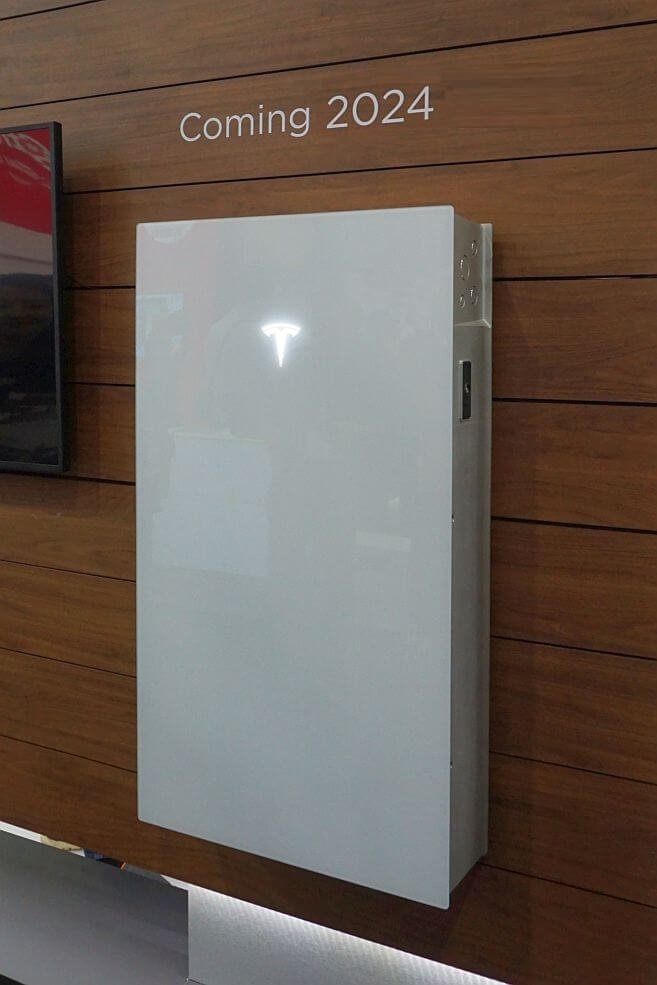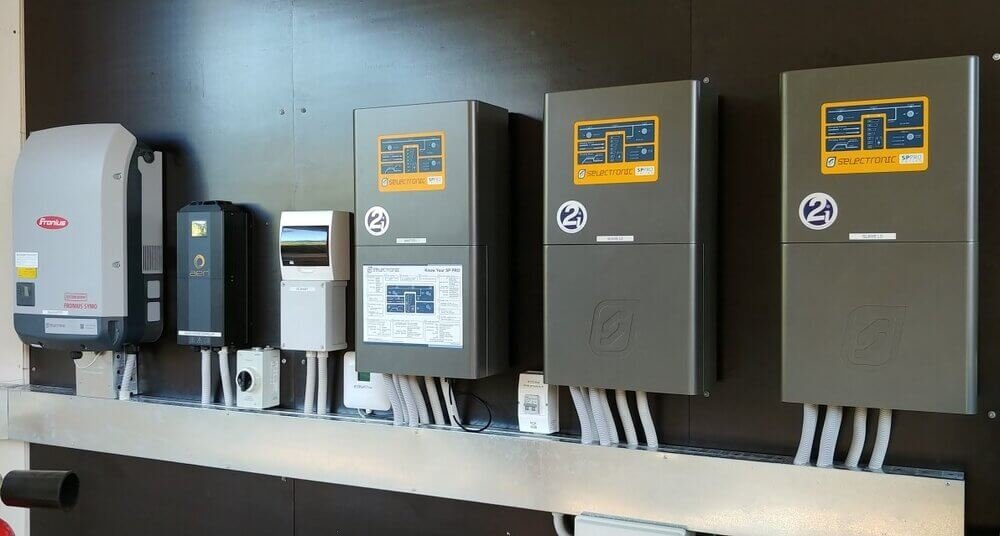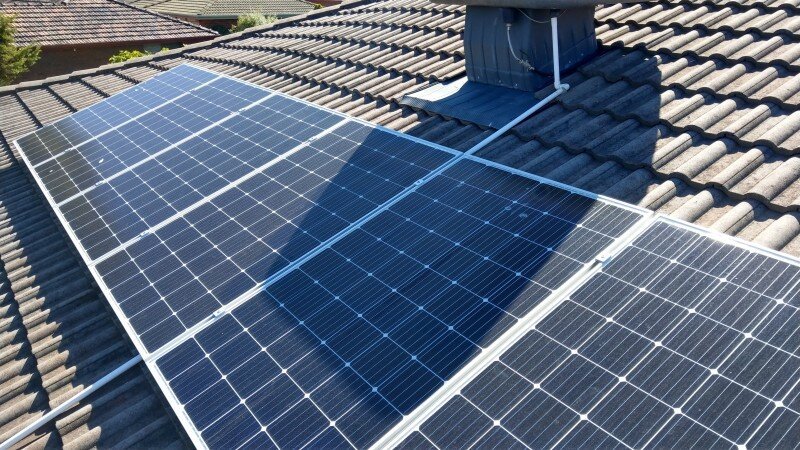Home Battery Storage Explained
Guide to Buying Solar > 3. Battery Storage
Batteries for solar energy storage are evolving rapidly and becoming mainstream as the transition to renewable energy accelerates. Until recently, batteries were mainly used for off-grid solar systems. However, the giant leap forward in lithium battery technology has seen immense interest in people wanting to store excess solar energy, increase self-consumption and become more energy-independent. Additionally, with frequent extreme weather events causing grid-wide blackouts, households and businesses are looking for ways to ensure a reliable electricity supply during prolonged disruptions.
In this article, we explain some of the advantages and disadvantages of home battery systems, provide a battery cost guide, present some alternative options to using batteries, and present a detailed comparison of the leading battery storage systems used in both off-grid and on-grid solar systems. For those new to solar, you can learn more about the basics of solar and the various energy systems, including grid-tie, off-grid and hybrid battery systems.
Different Types of battery systems
The Soltaro (all-in-one) solar battery system
The wide range of battery options and energy storage systems can be overwhelming for many people and the rapid pace of technology has resulted in some confusion over which type of battery is best suited to individual needs. Adding to the complexity are the many different battery configurations now available.
Generally, the best way forward is to get advice from a solar company and learn about the different battery options. However, this isn’t always reliable as some companies have limited experience with batteries and are unfamiliar with the many different AC and DC-coupled battery configurations. Fortunately, this is where we can help. The team behind Clean Energy Reviews have been installing and monitoring energy storage systems since 2014 and has some insightful tools and detailed reviews to help you understand what type and size battery is best suited to your needs. That said, many solar professionals are experienced and can offer the best system to suit your needs or what will work best if you already have an existing solar system.
The three main types of batteries
Lead-acid batteries - Traditionally used for off-grid power systems but are not widely used today
Lithium-ion batteries - Now the most common type of battery and advancing rapidly
Flow batteries - Generally used for larger energy storage applications and gradually evolving
Traditional battery systems were made up of deep-cycle lead-acid batteries. However, over recent years, different variations of lithium-ion batteries have dominated due to the many benefits of lead-acid batteries, including lightweight, scalable, high efficiency and long life. Large companies such as LG and Samsung began releasing lithium battery systems back in 2015, but interest rapidly increased with the announcement of the Tesla Powerwall; this was when home storage batteries really hit the mainstream.
How much do battery systems cost? See our detailed cost guide of the leading solar battery systems.
Should you get a Home battery?
SolarEdge Hybrid inverter installed with a 10kWh LG Chem RESU battery - Image credit Skyline Solar
There is a lot of debate about whether a battery system is cost-effective. The relatively high upfront cost and longer payback usually mean they are not a great financial investment. However, as solar feed-in tariffs (credits you get for feeding excess solar into the grid) reduce, the numbers start to stack in favour of batteries. Our free solar and battery calculator can give you a good insight into the costs and savings of various battery systems.
For many people, economics is not the primary driving factor for purchasing a battery. There are many other valid reasons for households and businesses to invest in battery storage from the feel-good factor to providing backup power in the event of an emergency. In our opinion, self-sufficiency and energy security are both valid reasons. A battery can significantly increase energy independence using solar and help accelerate the transition to a renewable-powered electricity system.
Advantages of home battery systems
Reduce emissions - Reduce pollution and demand from coal and gas dependent power grids
Be blackout safe - Provides backup power during a blackout or emergency
Reduce cost - Save money by using less energy from the grid
Become energy independent - Store your excess solar energy to reduce your grid usage
Reduce peak demand - Supporting the grid during peak times and provide grid stability services
Disadvantages of home battery systems
Higher upfront cost - Adds much more to the total system cost
Complexity - Requires a hybrid inverter or additional monitoring equipment
Space - Requires more room and should be installed in a secure area out of direct sunlight
Adding more Solar Vs adding a Battery?
Using solar alone, many average households can easily cover 50% or more of their electricity needs. Without a battery, this can even be increased to 75% or higher by changing habits and using simple timers or ‘smart’ controls to turn on high-consumption appliances during the day to be powered directly by your solar. This includes things like electric hot water systems, heating/cooling systems, pumps, dishwashers, dryers, and even cooking using ovens or slow roasters. After maximising self-consumption, a battery can enable you to become almost entirely energy-independent. By almost, we mean you can generally cover 100% of your average daily electricity requirements using solar and an appropriately sized battery, but there will always be times during poor weather when you cannot generate or store enough energy to cover your daily requirement.
Our free solar and battery simulator can provide you will a good estimate of the best size solar and battery system for your household.
EV charging from solar and a home battery
The average Electric Vehicle has a 60kWh battery, which requires a lot of energy during charging and could quickly drain an average 10kWh home battery. Considering this, charging an EV directly solar during the day is a much more effective option, and can be achieved using a common 6 to 8kW solar system and an average-sized home battery. However, this can be challenging during winter or if you travel long distances and are away during the day. Learn more in our solar EV charging explained article.
What size battery should I get?
The BYD lithium battery is a stackable modular battery storage system - Image Credit BYD
Before we get into too much detail, you should first understand the basics. Battery capacity is measured in kilowatt-hours (kWh) and most (lithium) battery systems are modular and scalable, so you can generally get a battery sized to suit your needs. Note, the old sizing terminology used with Lead-acid batteries was Amp-hours (Ah), but this is now mostly superseded with kWh being the industry standard for modern lithium batteries. See more information about solar and battery sizing here.
The next point you should know is roughly how much electricity your household or business consumes over an average 24 hour period. Electricity is also measured in kWh and your bill should give you a good idea of how much electricity you use per day. Generally, an average household consumes around 20kWh per day, but this might be higher or lower in mid-summer or mid-winter, depending on your local climate. Another factor to consider is how much electricity you use in the peak evening period (4pm to 9pm) which is often when the cost of electricity is at its highest, depending on your service provider.
What is the average size home battery?
Over the years of installing and monitoring home battery systems, we have found the most economical battery size for an average home is typically 6kWh to 10kWh. However, for modern all-electric homes and those with home electrical vehicle chargers, the optimum battery size for maximum self-consumption is increasing. Every household is different, and there is no one-size-fits-all solution, luckily this is where our free solar and battery sizing calculator can help.
Can batteries be added to an existing solar system?
Yes, a battery can be added to any grid-connected solar system using an AC-coupled battery such as the Sonnen ECO or Tesla Powerwall. Retrofitting a battery can also be achieved using a special hybrid inverter designed for AC-coupled batteries. One such option is the SMA Sunny Boy Storage inverter, which can be used to retrofit the popular BYD battery. Soltaro and Goodwe also supply cost-effective AC-coupled battery inverters.
What is a battery-ready system?
A sungrow hybrid or ‘battery ready’ inverter operating without a battery.
A battery-ready system is really a marketing term used to describe a solar system that uses a hybrid inverter rather than a standard solar inverter. A hybrid inverter is essentially a solar inverter with integrated battery connections and controls, which makes installing a battery much easier if you decide to add one in the future. The problem is that ‘battery ready’ or hybrid inverters are typically 30% more expensive than a standard solar inverter, and due to the rapid evolution in battery technology, finding a compatible battery may be difficult after a few years.
If you are seriously considering a battery in the near future, but are not sure what size battery will suit your needs, it is generally worthwhile investing in a hybrid inverter and using the inverter monitoring App to measure your consumption and solar performance over a 12-month period. This way, you can accurately gauge your consumption and make an informed decision about what size battery you should purchase. For example, there is no point in buying a sizeable 15kWh battery if your system does not generate enough excess energy to charge the battery during the year due to shading, poor weather or high consumption.
How much does a Home battery system cost?
The cost of a home battery system depends on the battery size or capacity measured in kilowatt-hours (kWh) and the type of inverter used. Household batteries typically cost anywhere from $4000 for a smaller 4 to 5kWh battery up to $15,000 for a larger 10 to 15kWh battery, depending on the type of battery, installation location, backup power requirements and type of hybrid inverter used. On average, energy storage batteries cost around $1000 per kWh installed. Our solar and battery calculator will help give you a clearer insight into the cost of the most popular battery systems.
Home Battery Backup options
Most hybrid (battery storage) inverters can provide emergency backup power for simple appliances like lights, fridges and TVs. However, if you require a high-powered backup system or need instantaneous backup power (like a UPS system without a delay), the best option is an advanced multi-mode inverter which are also used for off-grid systems. In Australia, we would recommend the Selectronic SP PRO or Victron Multiplus inverters, while in the USA, we would recommend the Outback Radian, Schneider Electric or Sol-Ark inverters. These high-powered inverters are designed to operate on and off-grid modes and can power large appliances like heating systems, pumps, and compressors. These powerful inverters are also compatible with many leading off-grid battery systems.
An increasing number of cost-effective ‘hybrid’ solar inverters with UPS capability for instantaneous backup power are available. These include the Sungrow SH-RS series, Goodwe ES series, Soltaro hybrid and Huawei SUN2000L1.
Batteries for off-grid solar
Modular off-grid battery system from Powerplus energy.
There are many lithium battery systems used for off-grid applications but not all lithium batteries are really suitable for off-grid use. For smaller capacity systems there are several 48V options from LG chem and BYD. However, for higher capacity off-grid systems the modular lithium batteries from manufacturers such as Simpliphi in the US, or GenZ and Powerplus energy in Australia offer a more reliable, flexible choice. These modular LFP rack mount battery systems, known as self-managed lithium batteries work with many of the dedicated off-grid multi-mode inverters.
See our detailed review of the leading off-grid solar battery systems.
Battery configurations - AC and DC coupled systems
Over the years, manufacturers have developed many battery options and configurations to suit different applications and types of installations. This includes AC-coupled batteries like the well-known Tesla Powerwall and Sonnen ECO, which can be easily fitted to homes with an existing solar system, and DC-coupled battery options, which work in conjunction with a hybrid or off-grid inverter.
DC-coupled batteries - Require a compatible hybrid or off-grid inverter to operate
AC-coupled batteries - Contains a battery together with an integrated inverter-charger
A typical AC battery system which can be retro-fitted to any home with solar - Tesla Powerwall battery shown
With any type of energy storage system, there are many important features to consider when selecting and sizing the various components. For installers and professionals, we have also created the technical guide to hybrid and off-grid energy storage systems, highlighting the key features and specifications which should be considered.
















